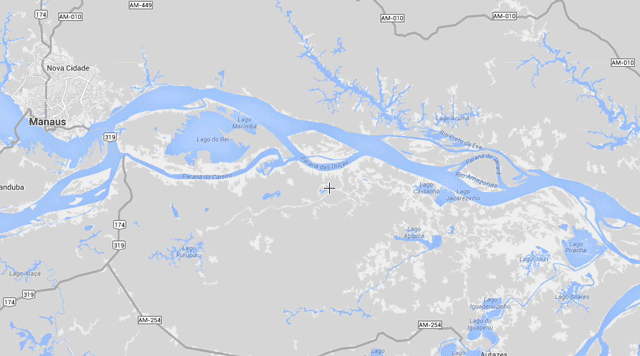News•September 3, 2014
UN Highlights Climate Big Data Ahead of Summit

By Brian Kahn
Data is buzzing around us all the time. Whether you realize it or not, you utilize data everyday, be it in figuring out how much your daily cup of coffee costs or how long it takes you to get to work.
Now imagine doing that on a much bigger picture, organizing millions of pieces of information and making it useful. That’s exactly what scientists are up to when they talk about big data, including when it comes to climate. The United Nations recently highlighted two projects focused on bringing this approach to climate problems ahead of the upcoming climate summit in effort to show how data can be used to solve global and local problems.
An animation showing forest loss near Manaus, Brazil.
Credit: Global Forest Watch

The projects are Global Forest Watch, a forest mapping tool, and a cropping tool for Colombian rice farmers. Both are winners of the UN Global Pulse Big Data Climate Challenge, which received entries from research teams in 40 countries working across 20 disciplines.
“On the ground, action is already taking place and proving new ways that data can help,” Miguel Luengo-Oroz, the chief scientist at Global Pulse, told Climate Central in July.
He said that showcasing them at the UN Climate Summit later this month provided an opportunity for other scientists and policymakers to see how these projects were implemented and consider how they could translate them to their areas of research.RELATEDWhite House Brings Together Big Data & Climate Change
NOAA’s New Cool Tool Puts Climate on View for All
Breathtaking Coral Reef Panoramas Help Scientists
Global Forest Watch, put together by World Resources Institute, blends near real-time satellite monitoring of the world’s forests with crowdsourced stories and past data on forest changes. Though the tool provides a global overview of forests, the data resolution is sharp enough to benefit decision makers on the community level.
While local forest changes matter to communities that rely on them, they can also add up to have a strong impact on the climate. Large fires in the northern stretches of the globe’s forests have recently served as a strong reminder that boreal forests stretching across Canada, Alaska and Russia hold 30 percent of the globe’s land carbon. And in tropical countries, deforestation from slash-and-burn agriculture is another potential source of carbon dioxide emissions and driver of climate change. Big data can help scientists and policymakers better monitor those changes and account for them in climate models and negotiations.
The other winning project is a rice farming tool developed by the International Center for Tropical Agriculture (known by its Spanish acronym, CIAT), which incorporates a mix of weather and harvest monitoring data along with climate forecasts to provide recommendations to farmers about what types of rice to sow and when.
“Climate change obligates us to manage our food systems in a more dynamic way, and big data offers the most effective way to achieve this. Like the hoe and spade, these new tools are becoming crucial implements for global food production,” CIAT scientist Andy Jarvis said in a blog post.
The impacts of climate change on food security are a major concern in the developing world where population growth rates are highest and agriculture is a crucial piece of the economy. A report from International Food Policy Research Institute indicated that by 2050, climate change could shrink crop yields for staples including rice, wheat, sorghum, and maize by up to 20 percent in East Africa. The spread of pests could further decrease yields if adaptation measures aren’t taken.
Data hasn’t traditionally been seen as a form of adaptation, but with projects like these it’s easier to envision it as one (or at least a means to an end).
You May Also Like:
Wind, Solar Boosting Investment in Power Lines
Visualize It: Old Weather Data Feeds New Climate Models
For Air Pollution, Trash Is a Burning Problem
Climate Change Ups Odds of a Southwest Megadrought